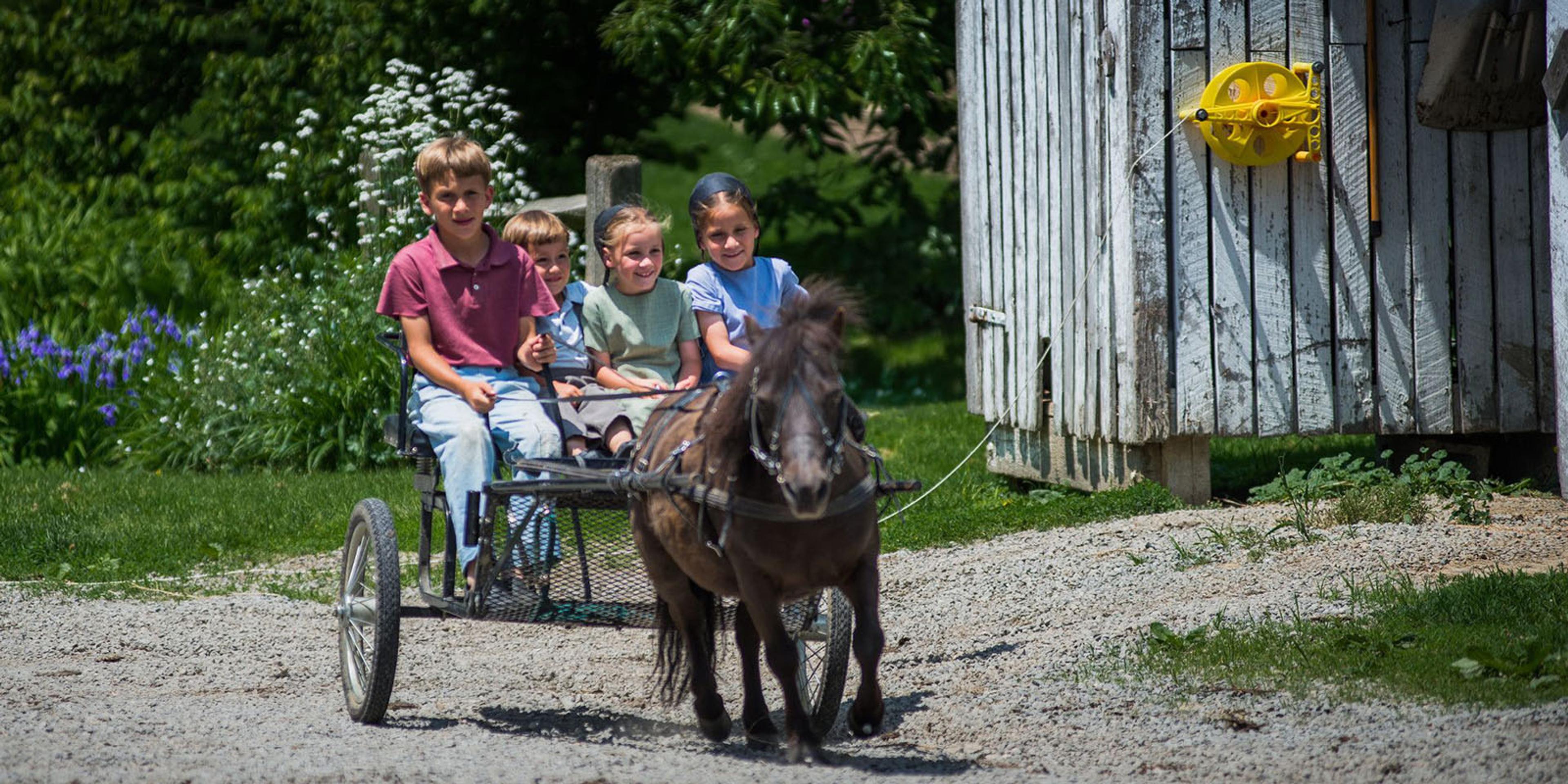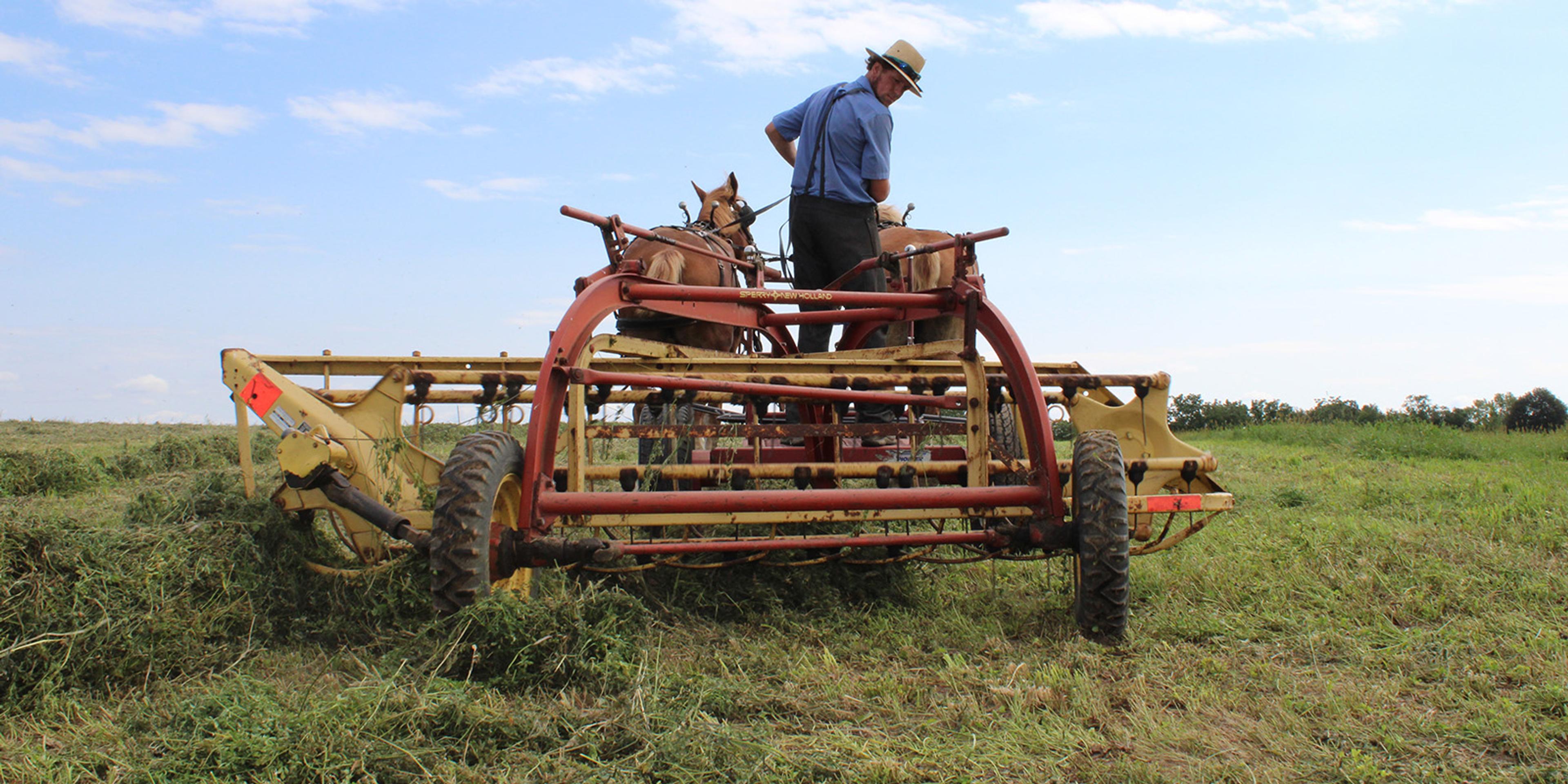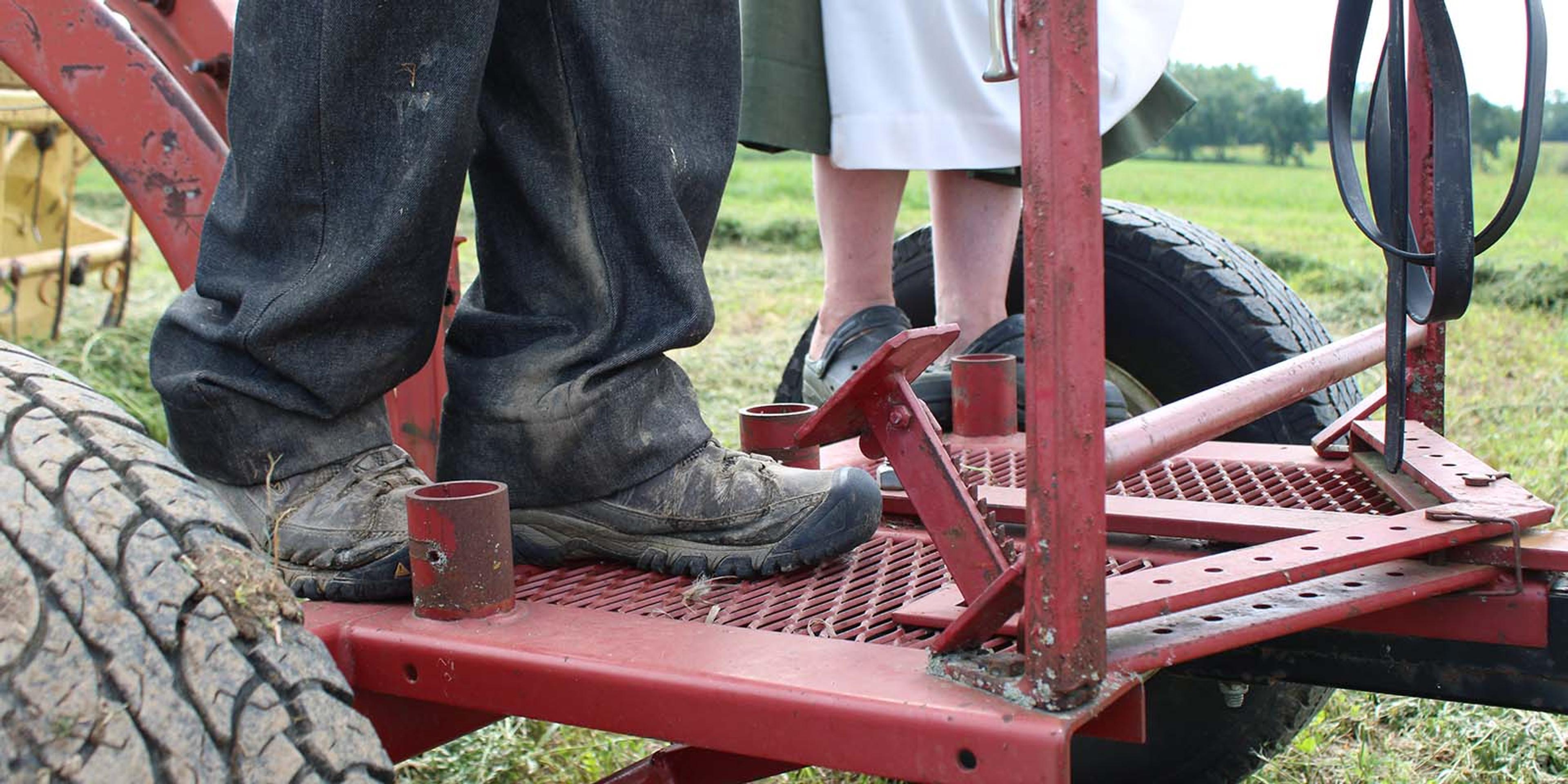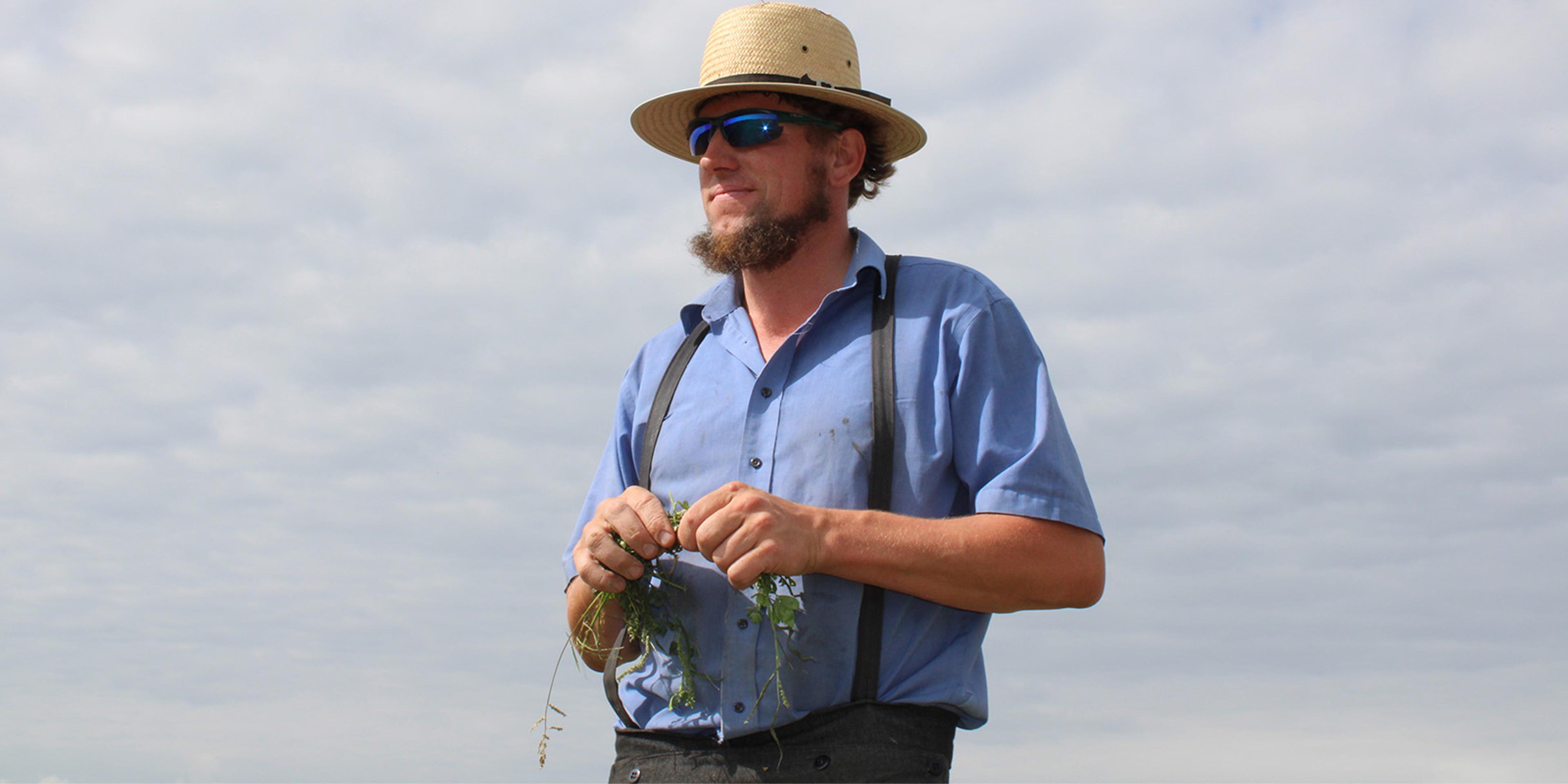
Farming
A Look Into Why Amish Farm With Horses
Dan and Malinda Hershberger lead two Belgian horses out of their barn in southwest Wisconsin on a sunny September morning. Kelly and Mindy, 1,800-pound workhorses, are gentle and easy to take to the awaiting hay rake. As the Hershbergers prep them for the field, the horses neigh and seem to understand when Dan says, “back up, woah.”
About 43% of Organic Valley farmers are members of the Plain community, including Amish and Mennonite members. Many use horses for fieldwork and transportation.
How do Amish communities manage to farm using horses, and why do they stick with horses when there are massive farm implements that can do the fieldwork in a fraction of the time? A number of Organic Valley’s Amish members shared how they take on tasks.

Malinda Hershberger, Wisconsin, readies the team for the field.
Why Do Amish Use Horses?
Jerry Miller of Ohio said there are a number of reasons Amish use horses. It limits the number of acres a person can farm, making room for others to farm, thus creating tight-knit communities.
“Instead of one farmer farming 1,000 acres, we have 10 farmers now farming 100 acres apiece,” he said. “As Amish people we cherish community. Community to us trumps everything.”
Horse transportation also limits the number of miles the Amish community can travel—another way to tighten the community.
David Hershberger (no relation to Dan and Malinda) said farming with horses is part of their culture and also a way to ensure the family takes time for each other.
“Horses get tired, so you have to stop. The horses need a break as well as people do. It’s a really good thing. In the evening the horses are tired, so you have to quit. It keeps your family knit,” the Ohio farmer said.

Dan and Malinda Hershberger work the field.
Amish Animal Care
All Organic Valley farmers must meet the co-op’s high animal care standards. We believe animals should be allowed to express natural behaviors and be well cared for.
David said the horses are eager to please and raring to get in the field.
“I get a big ‘neigh’ if a horse sees other horses going out,” he said. “They want to go along. They don’t mind the work. One mare was a handful when she was a foal, but as soon as I throw a harness on, she is ready to go—she can’t wait to get out there.”
The horses are treated with the utmost respect. Horses help care for the farm and they are also worth thousands of dollars. Think of it like this: If you have a vehicle that you rely on to take you places, you are going to take care of it. If you intend to sell it, you want it in tip-top shape, too.
“We love these animals and we take care of them,” Miller said of his Percheron draft horses. “Not only do these horses work for us in the fields but we do sell some at auction.”
Percherons are calm and easy to get along with—very gentle. “They are like humans one to the next,” Miller said. The family’s horses have names: Bell and Barb are sisters, there is Delilah, Carlie, Lucy, and Wild One (who is a little, well, wild).
David has seven Belgian horses, three buggy horses, and a pony named Shorty that is the “babysitter.”
The children drive the pony cart on errands. “They enjoy the ride and he enjoys the ride. It teaches them a lot of good ethics about farming,” David said.

A miniature horse pulls children on Kevin Miller’s farm in Ohio.
Horses Get Many Breaks
Many Amish plow early in the season to accommodate the horses. Standard-bred horses are often used for transportation, and many stores in town have water for the horses. Farmers take hay for the horses to munch on during stops on longer horse and buggy trips.
Horses can tolerate a lot of heat, but farmers respect them and allow plenty of breaks. Dan and Malinda have 10 Belgian horses, and they replace working horses with others when plowing or haying to ensure they all have adequate down time.
Miller said their family is cautious of weather and other conditions and though the equipment may weigh 1,200-plus pounds, two horses barely break a sweat. They start in the field early in the day when it’s coolest.

Dan Hershberger, Wisconsin, rakes hay with the help of his horses.
Horses and the Impact on Environment
“It makes us more sensitive and closer to the land,” Miller said of working with horses.
When given proper pasture, horses can benefit the environment.
David said farmers can get in the field earlier in the year because horses do not compact the land like tractors, which can cause issues with water runoff and more.
Horses produce a lot of manure (55 pounds a day, according to the University of Minnesota Extension) that is spread on fields to help soil health, used as fertilizer for crops, and helps the water-holding capacity in soil.
Do Amish Use Farm Machinery?
Farm machinery is a must on any farm.
The Amish do not shun technology. However, Amish can only use certain technologies depending on their community’s rules. Some can only use small gas motors while others can use tractors. David said most Amish farmers use tractors but some churches (communities) are “really remote in their way of doing things.”
“The innovation that has gone into adapting to horse farming is nothing short of amazing,” Miller said.
Horse-operated farm machinery has advanced. Miller and Dan had good things to say about an implement business in Dalton, Ohio, called Pioneer Equipment. It develops horse-drawn equipment and is widely known by Amish farmers everywhere.
For those of you interested in the intricacies of farm equipment:
A forecart is essential for Dan and Malinda. The horses are hitched to the two-wheel cart, and the cart has a platform for the farmer to stand on while being driven (some have seats). A forecart has a brake and implements, like a hay rake, can be attached with a hitch pin like it would attach to a tractor.

A look at the brake on the forecart at the Hershberger farm.
The couple has used a power forecart which has a motor up front, transferring power to the power takeoff (PTO), which can be used for things like a disc bine to mow much-needed hay. Hay, dried grass, is fed to cows in the winter when they can't graze on green pastures.
Miller can mow 22 acres of hay with just 3 gallons of gasoline. He uses a forecart with a diesel engine on it, which is hooked to the baler, that is run by a PTO. He can get off 20 to 25 round bales in an hour. Round bales of hay can weigh 1,000 pounds or more!
Many brands of equipment are the same used by non-Plain community farmers, such as New Holland and Massey Ferguson. Dan and Malinda use a skid steer to lift hay bales that weigh far more than a human can lift.
Horses pull everything from manure spreaders to plows. Outside of the field, generators run milking equipment and some farms use converted gas-powered engines to pump water into the house.

Dan Hershberger, Wisconsin, talks farming.
To an outsider, farming with horses may seem like a chore. Not everything on a farm is a chore—David can harness six horses in 20 minutes and doesn’t mind as it keeps him connected with them. There is also joy in milking cows, tending fields, and sharing organic food with consumers. Families work together and communities stay together.
Dan and Malinda’s satisfaction is evident as they drove horses that sunny September morning. They enjoy the peacefulness of working the fields with horses, hearing the gentle sound of the horses' steps, and taking in ridgetop views as far as the eye can see.
All photos were taken with permission.
An antique typewriter fanatic and chicken mom who treasures time outdoors admiring all that nature has to offer, Jennifer McBride is Rootstock’s editor. McBride spent 15-plus years as a journalist and newspaper editor before finding her niche with the nation’s leading organic dairy cooperative. Contact her at Rootstock@organicvalley.com.
Related Articles
Tags:
- innovation,
- working together,
- animal care,
- farm labor,
- farm life


















